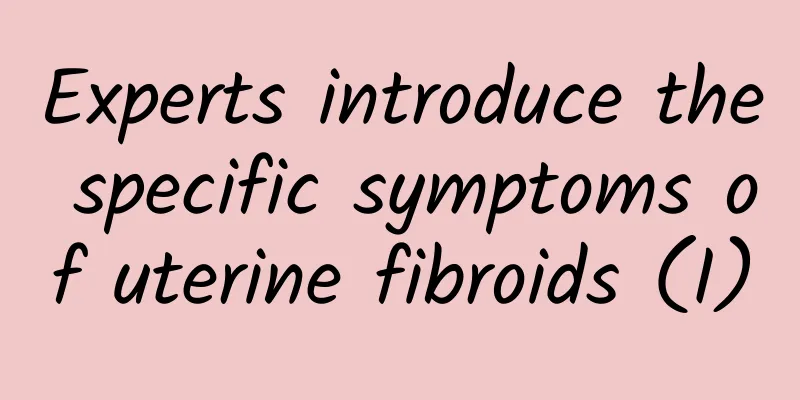Experts introduce the specific symptoms of uterine fibroids (I)

|
Experts remind that early detection and early treatment of uterine fibroids are the fundamental way to maintain health. So what are the symptoms of uterine fibroids? I hope the following experts' introduction can help you. Let everyone know more about the symptoms of uterine fibroids . 1. Infertility and miscarriage: 30% of patients with uterine fibroids are infertile. Pregnancy may be the reason for seeking medical treatment, and uterine fibroids are found during the examination. There are many reasons for uterine fibroids to cause infertility. 2. Compression symptoms: The symptoms of this type of uterine fibroids often occur in cervical fibroids, or are caused by the enlargement of fibroids in the lower part of the uterine body, which fill the pelvic cavity and compress the surrounding organs. Compression of the bladder can cause frequent urination or dysuria, urinary retention, etc. Compression of the ureter can cause hydronephrosis and pyelonephritis. Fibroids growing on the posterior wall of the uterus can compress the rectum, causing constipation and even difficulty in defecation. Compression of the pelvic veins can cause edema of the lower limbs. Compression symptoms are more obvious in the early stage of menstruation, which is due to the congestion and swelling of uterine fibroids. 3. Pain: Symptoms of uterine fibroids include abdominal pain in about 40%, backache in 25% and dysmenorrhea in 45%. Some patients also experience a feeling of heaviness in the lower abdomen or backache, but the degree is not very serious. The pain is caused by the tumor compressing the pelvic blood vessels, causing blood stasis, or compressing the nerves, or the pedunculated submucosal fibroids can stimulate the uterus to contract and be discharged from the uterine cavity, causing the cervical canal to widen and cause pain, or the necrosis and infection of the fibroids causing adhesion and traction in pelvic inflammatory disease. 4. Uterine bleeding: It is the main symptom of uterine fibroids, occurring in half or more of the patients. Among them, cyclical bleeding (excessive menstrual flow, prolonged menstruation or shortened menstrual cycle) is the most common, accounting for about 2/3, while non-cyclical (continuous or irregular) bleeding accounts for 1/3. Bleeding is mainly caused by intramural fibroids and submucosal fibroids. Cyclic bleeding often occurs in intramural fibroids. The above content is the symptoms of uterine fibroids introduced by experts. Please pay attention to it. I hope it will be helpful to you. If you have other questions about the symptoms of uterine fibroids, please consult online experts and they will give you detailed answers. For more information, please visit the uterine fibroids topic at http://www..com.cn/fuke/zgjl/ or consult an expert for free. The expert will then give a detailed answer based on the patient's specific situation. |
<<: Uncover the three high-risk groups for uterine fibroids
>>: Experts introduce the specific symptoms of uterine fibroids (Part 2)
Recommend
Tips to help prevent vaginal candidal infection
Candidal vaginitis is caused by fungal infection,...
How can female friends prevent breast cysts?
Breast cyst is a common disease among women, with...
What are the symptoms of cervical erosion biopsy in women? 7 symptoms of cervical erosion are suitable for biopsy
Many female diseases are always particularly emba...
What are the specific causes of cervical erosion?
Cervical erosion is a common disease, and female ...
What causes pelvic inflammatory disease? Not paying attention to hygiene during menstruation
Pelvic inflammatory disease is generally caused b...
What are the main causes of cervical erosion?
When it comes to the cause of cervical erosion, t...
How to repair pelvic floor muscle uterine prolapse
Uterine prolapse refers to the descent of the ute...
How much does it cost to test for bacterial vaginosis during pregnancy?
Bacterial vaginosis is the most common gynecologi...
Women should pay attention to their diet after artificial abortion
Before 24 weeks of pregnancy, women use artificia...
Experts analyze the causes of irregular menstruation
Irregular menstruation is a physiological disease...
What tests should patients with threatened abortion undergo when they go to the hospital?
When it comes to threatened abortion, female frie...
What causes right ovarian cyst? Is it related to diet?
Generally, ovarian cysts, even bilateral ovarian ...
Follow these 3 methods to significantly reduce uterine cold
Palace cold is a symptom that troubles many women...
Basic drug therapy for menopause
We all know that menopause will accelerate the ag...
Eat the right protein to lose weight more smoothly
Many people go on a diet to lose weight, eating o...









